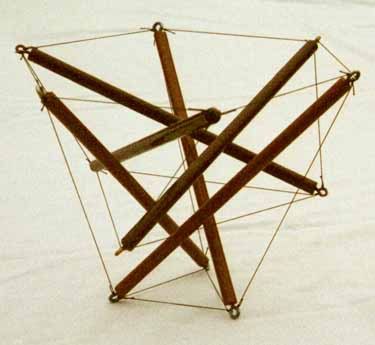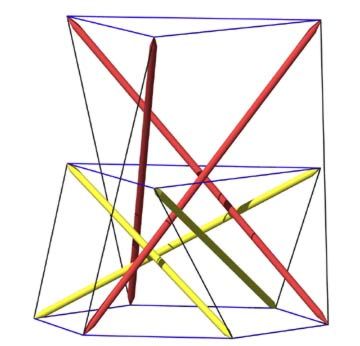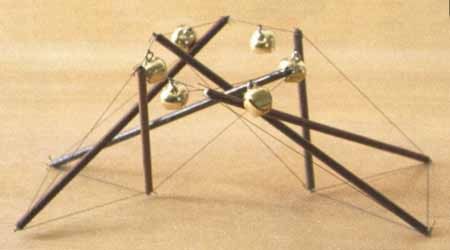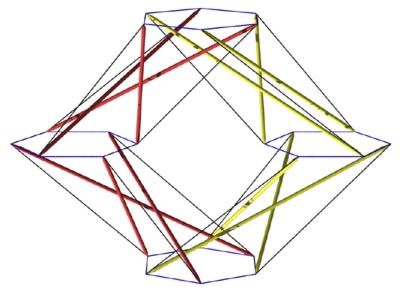
Split-Level Prism I

This is an evolution of the Six-fold Equi-tendoned Prism. Since in that prism the side tendons skip a strut (instead of connecting adjacent struts as is usually the case with tensegrity prisms), it can be viewed as two three-prisms whose ends are merged. Three-prisms with merged ends were also seen in the Tensegrity Mast. Here however both prisms are on the same side of two ends they share instead of being on opposite sides of the shared ends as in the mast. If the independence of the two three-prisms is restored at one end and one of them is shortened, and the other three-fold end contracted to maintain equality of strut lengths, the split-level prism above is the result. This example is standing on the contracted three-fold end.
On January 22, 2008, I prepared a datasheet for a variation on this structure. I completed building the corresponding model on January 28. The model seems to display itself to best effect supported on the triangular "apex" rather than the hexagonal "base."
This evolution can be continued by reversing the sense of one of the prisms, so they now have opposite sense (or as Alan Michelson in email to Synergeo on December 27, 2007, more accurately puts it, “reversing the chirality of either prism”):

This evolution can be further continued (for either of the previous prisms) by keeping the two prisms at the same height and skewing their independent ends away from each other. If this structure is turned with the shared end so it is away from any supporting surface, a sort of arch is obtained (call it the Wishbone Tensegrity) as in the model photograph below. The model photographed below has jingle bells attached, one per hexagon side, so it can serve as a motion detector.

I put together a datasheet for a realization of the Wishbone Tensegrity on January 11, 2008. I completed the model on January 17.
A yet further evolution takes two Wishbone Tensegrities and bonds their two pairs of ends to each other to get a cyclical diamond-shaped structure:

For a finale, take two wishbone tensegrities, skew them orthogonal to the original skew and bond their ends together so the bonds keep both prisms on the same side of the bond. This yields another cyclical structure, but now with a tetrahedral configuration rather than a diamond one:

In this last structure, with all the bonds configured so both prisms are on the same side of the bonds, designing to avoid interference problems is a challenge. The green struts closely approach another strut and tendon at one end. Perhaps jiggling the parameters a bit would bring it into a better mean if not a completely happy one. Initial designs resulted in tendons and struts going through each other -- something I didn't want. So, even though some clearances in my final model are less than I'd like, it seems feasible with care. The centers of the hexagons are located at the vertices of a regular tetrahedron. Since I neglect two edges of the tetrahedron, Alan Michelson in email to Synergeo has suggested (December 27, 2007) “it's more like a Skew Quadrilateral” which seems a reasonable way of looking at it as well.
The first of these designs were completed on November 21, 2007. Two designs were modified on December 7, 2007, to use a different version of the wishbone and shorten them by two-thirds so the centers of the hexagons in the diamond-shaped prism formed a square. Designs for a second version of the split-level prism and the tetrahedral prisms were added on December 26, 2007. All the current versions are available for inspection in the Dynamic Tensegrity Views.


